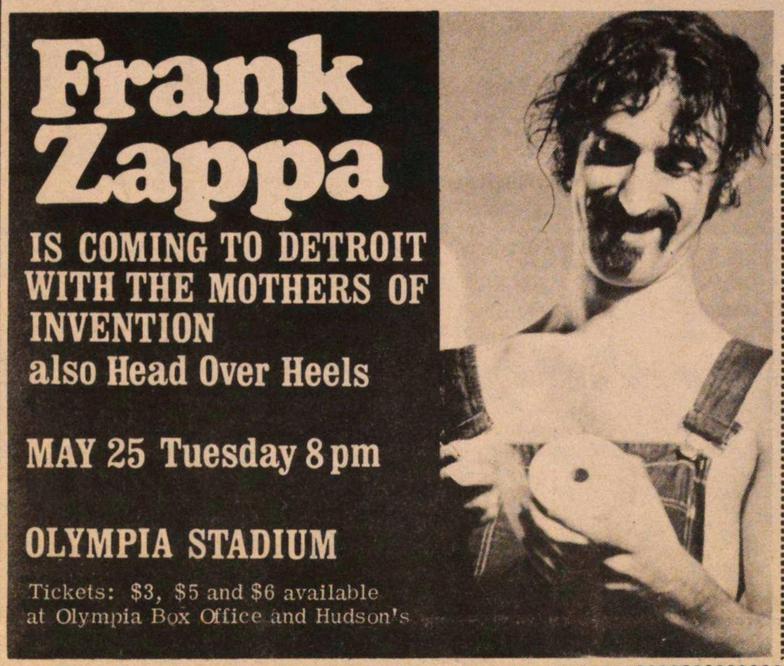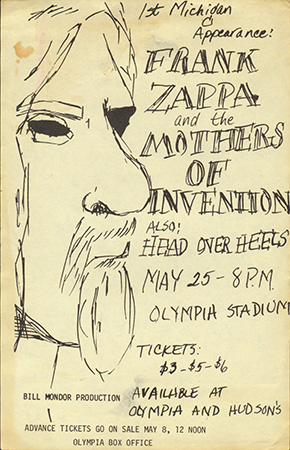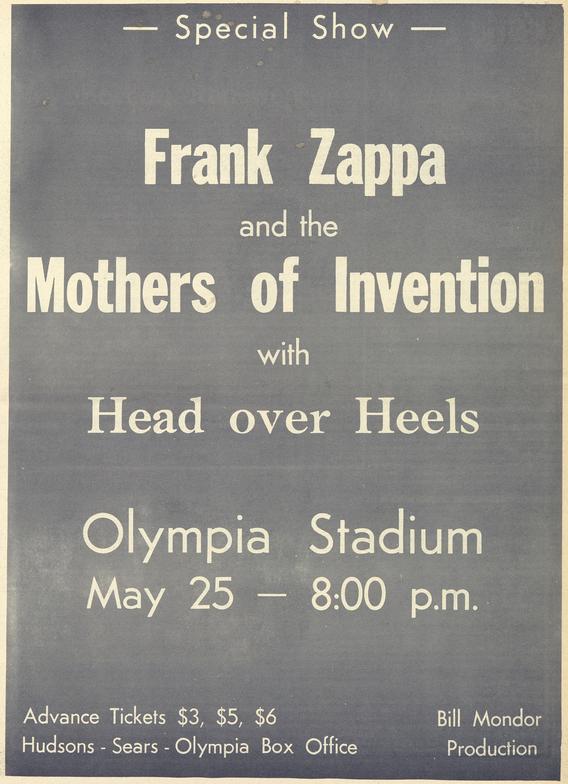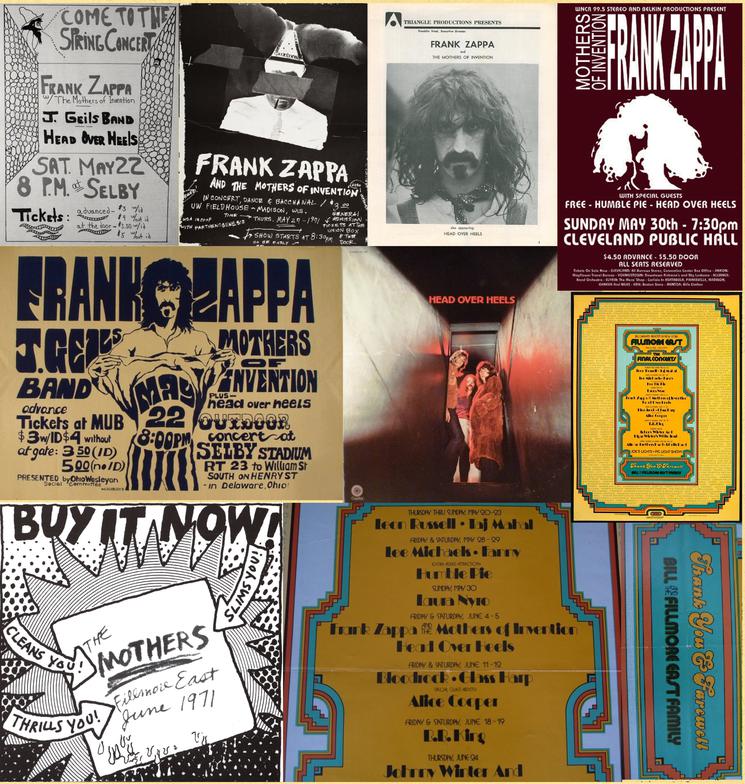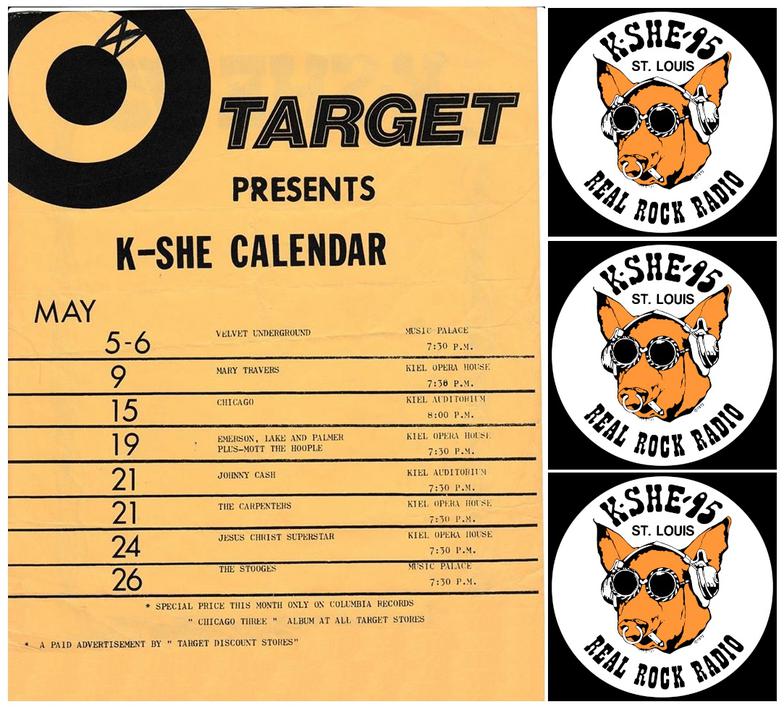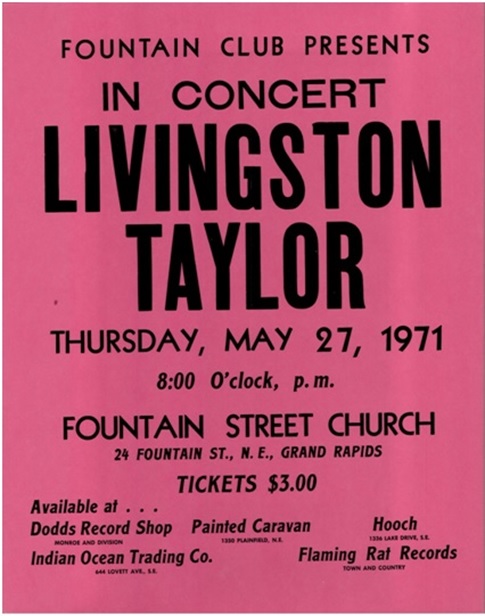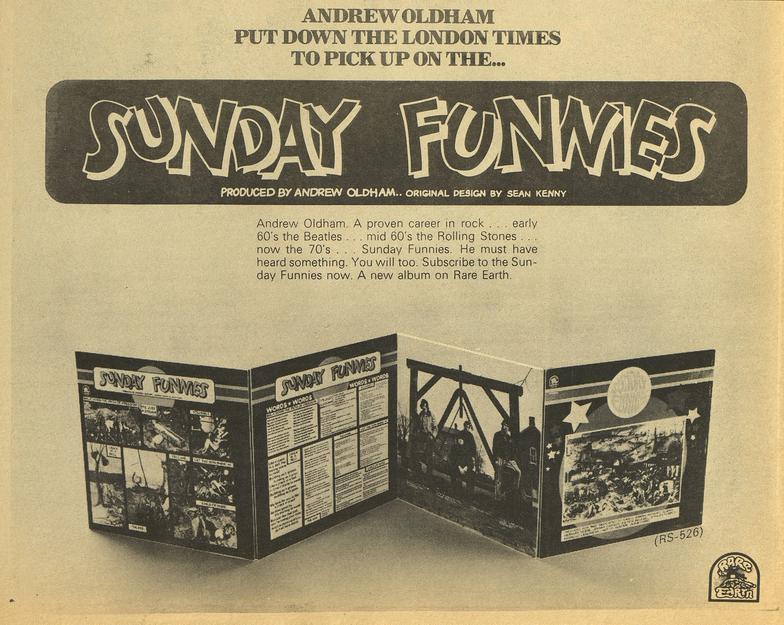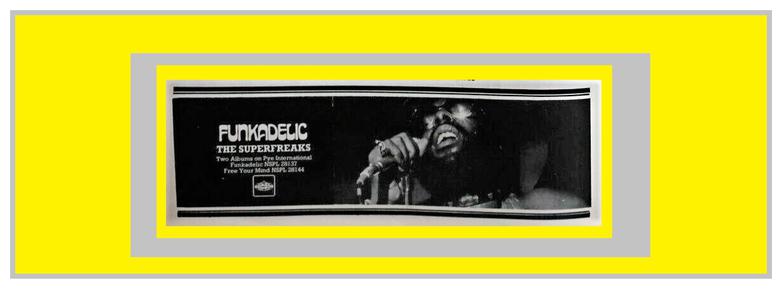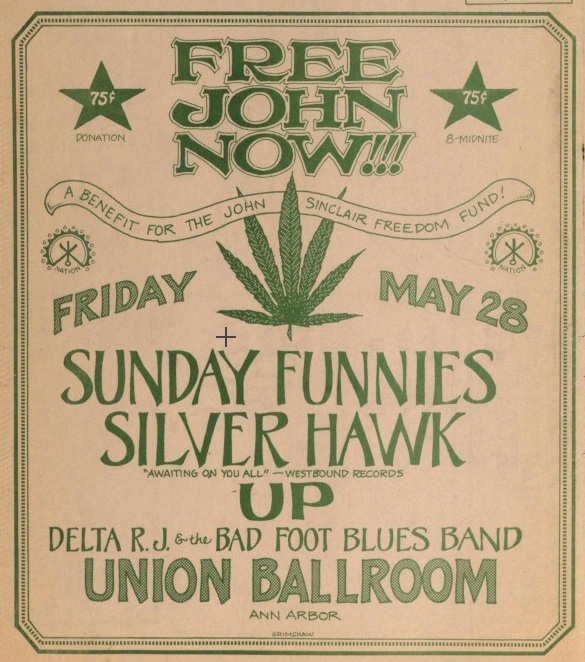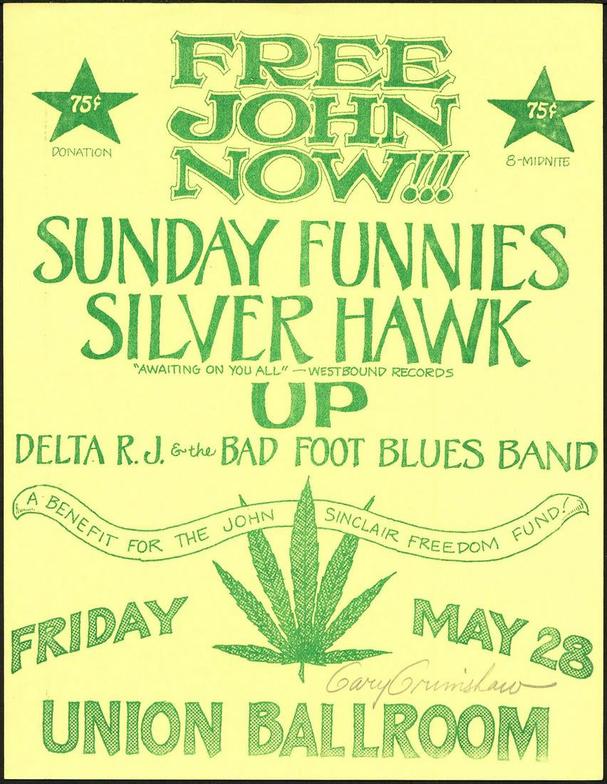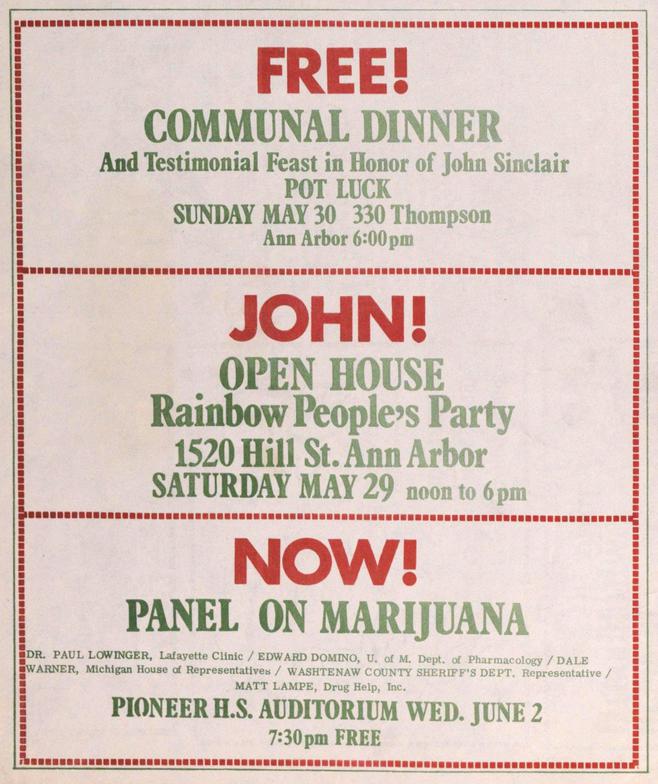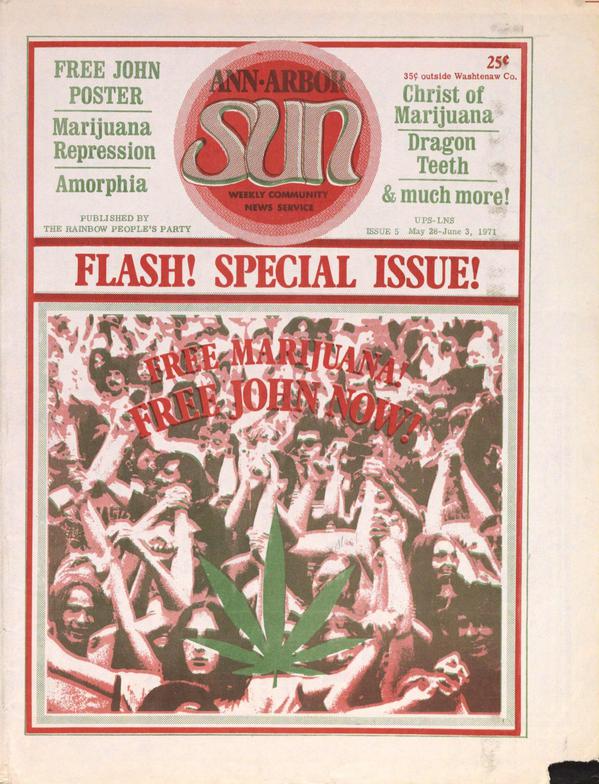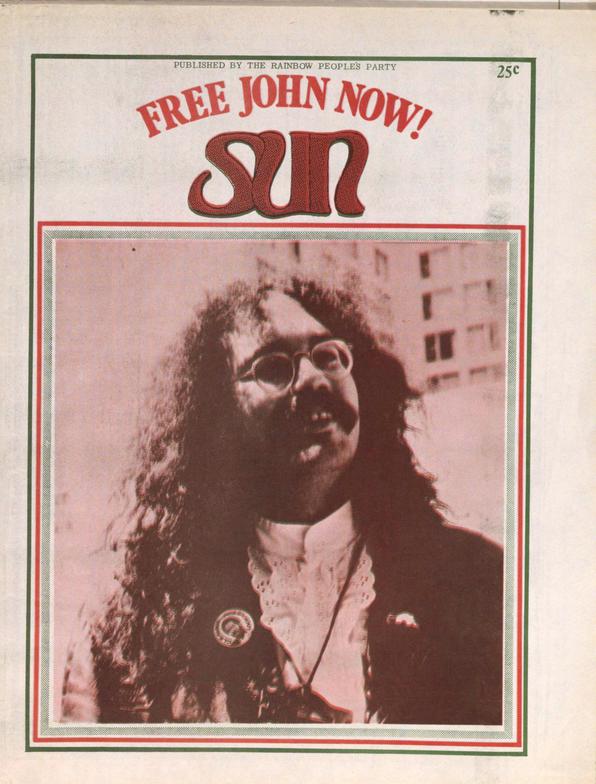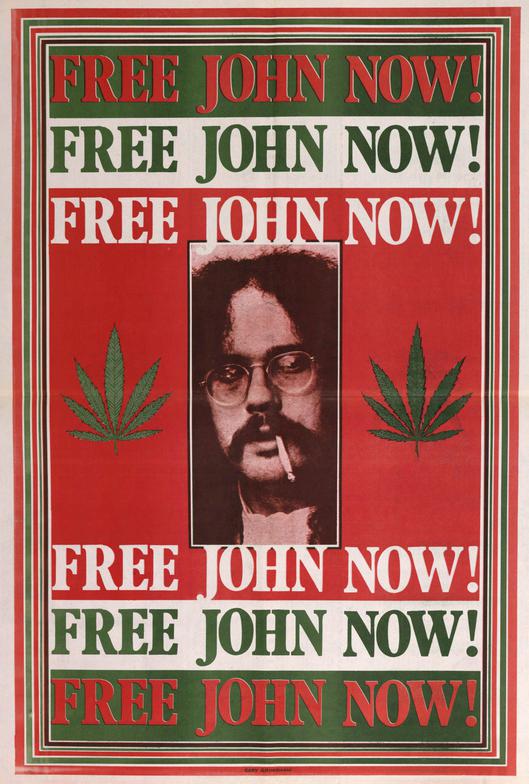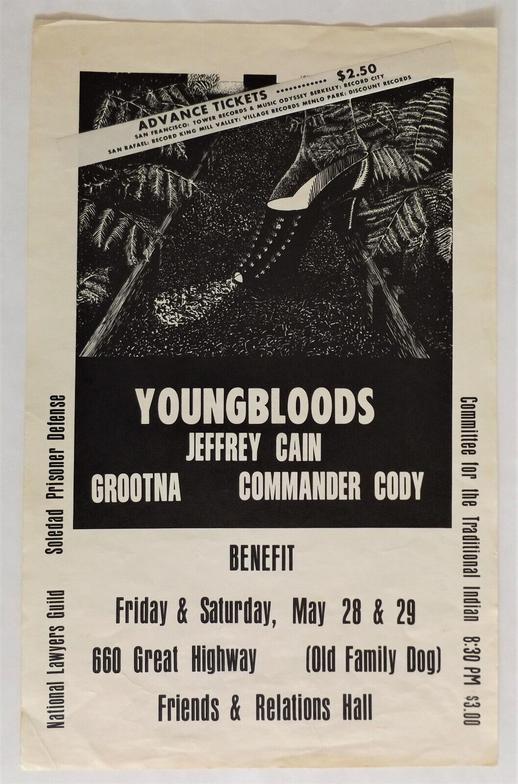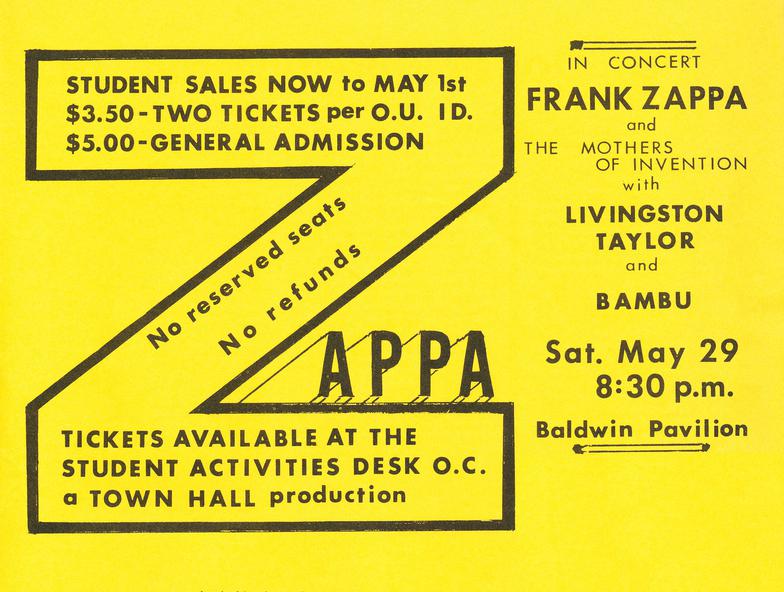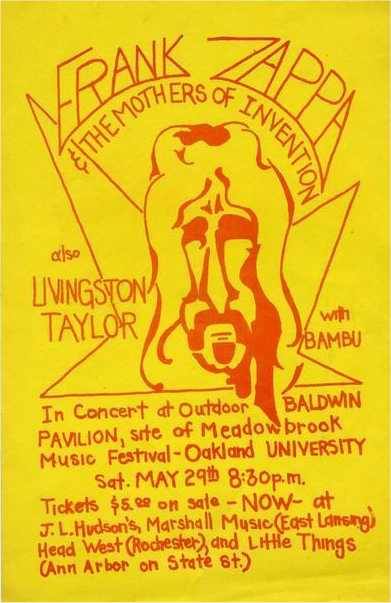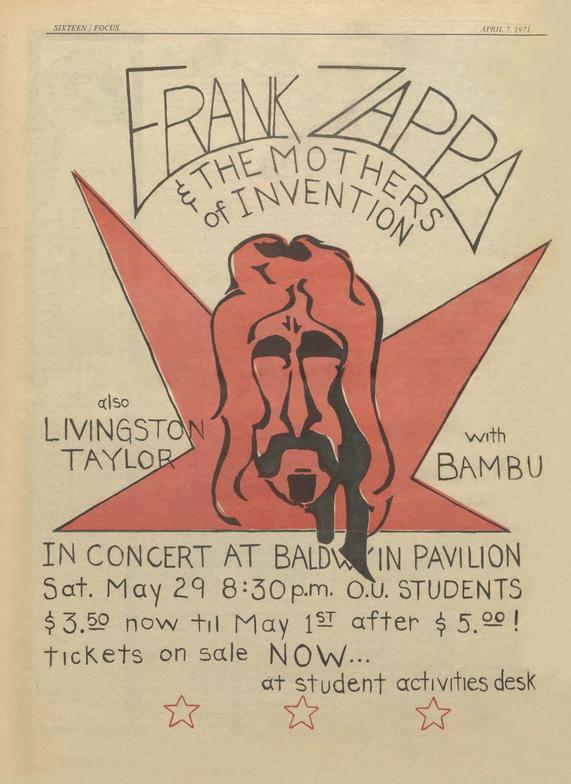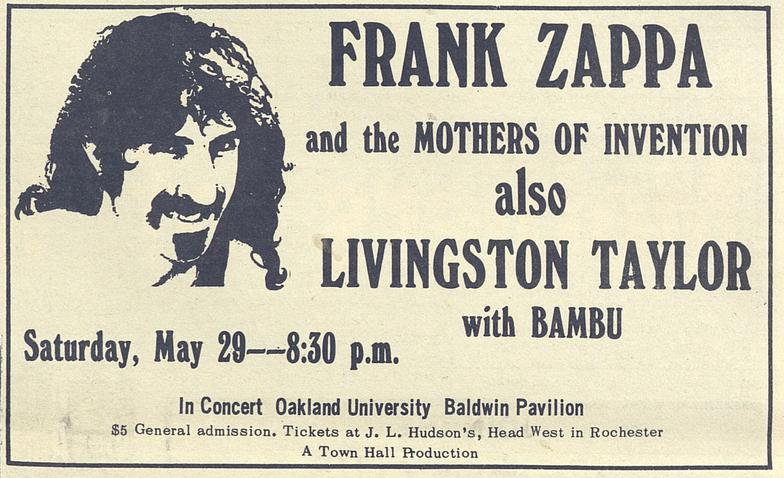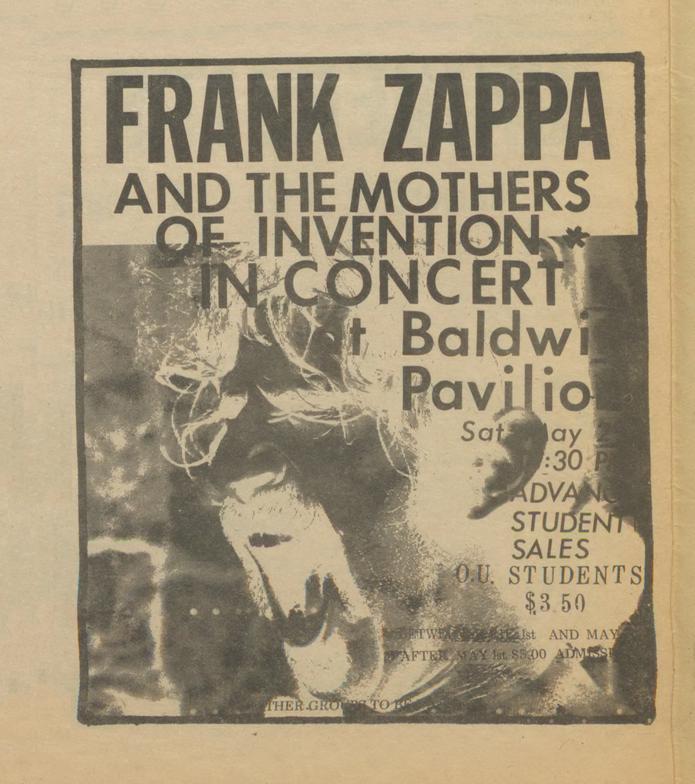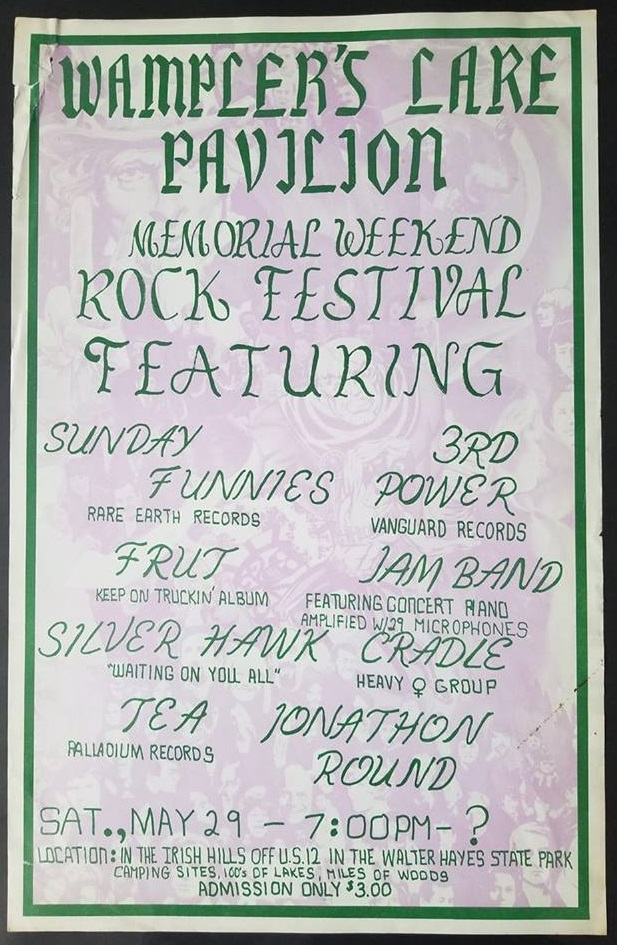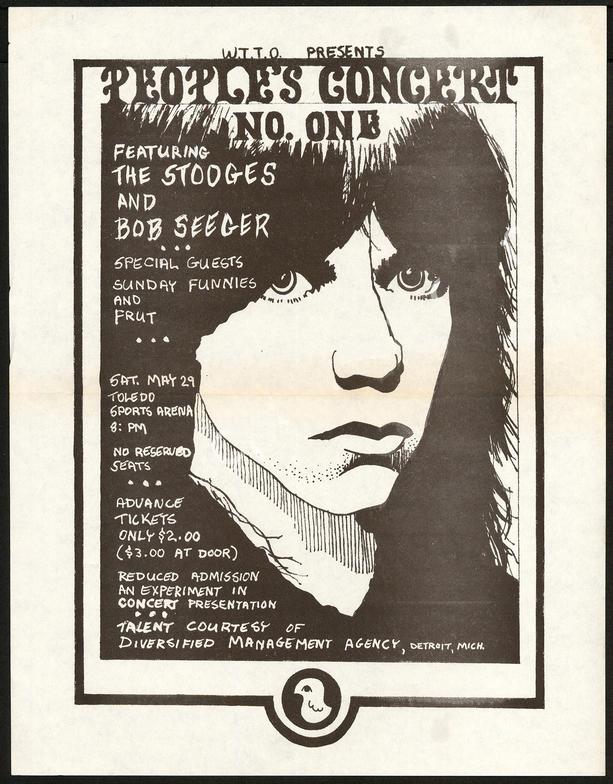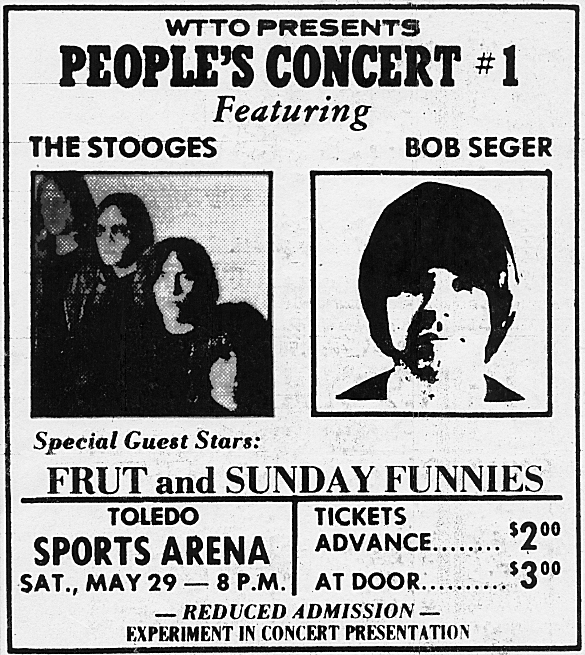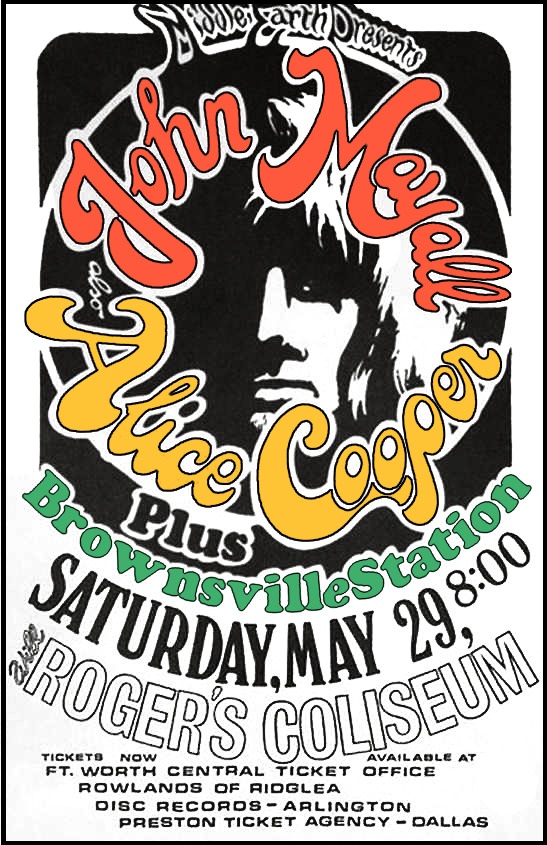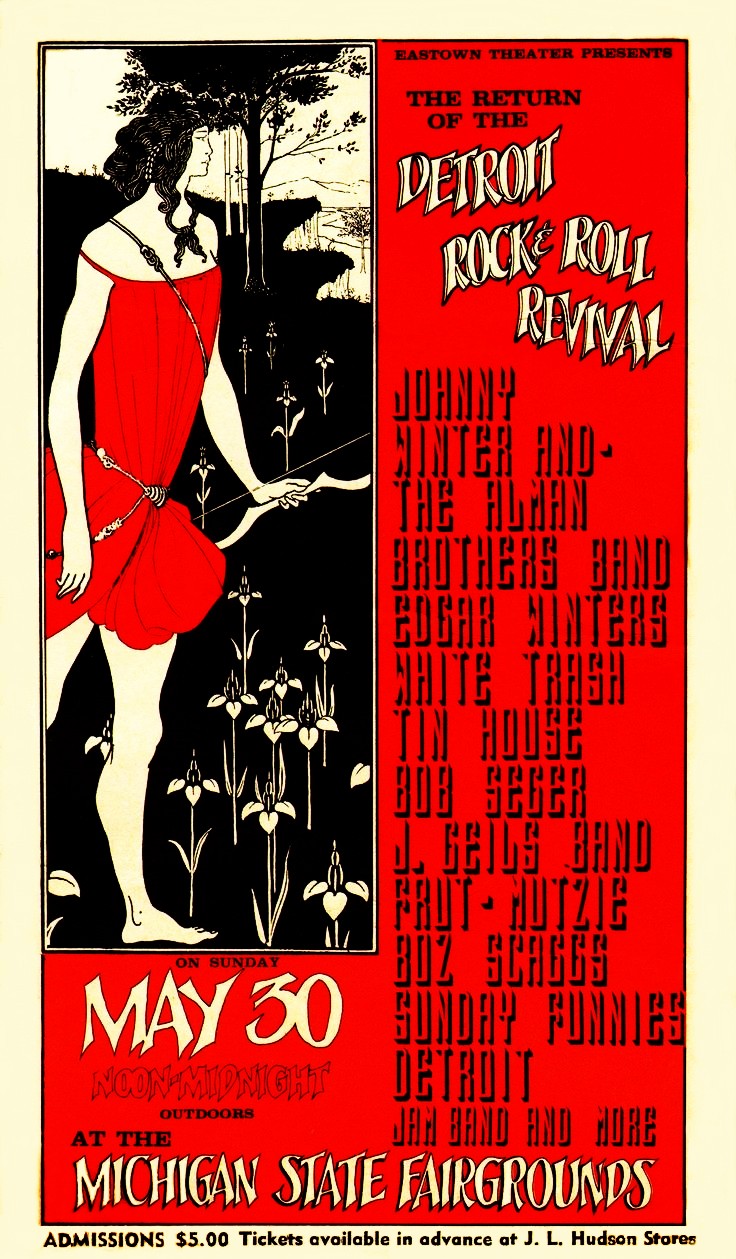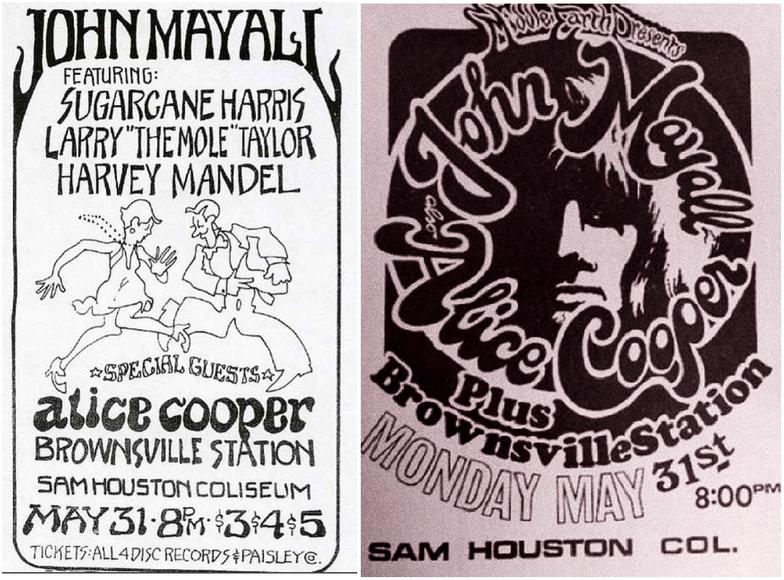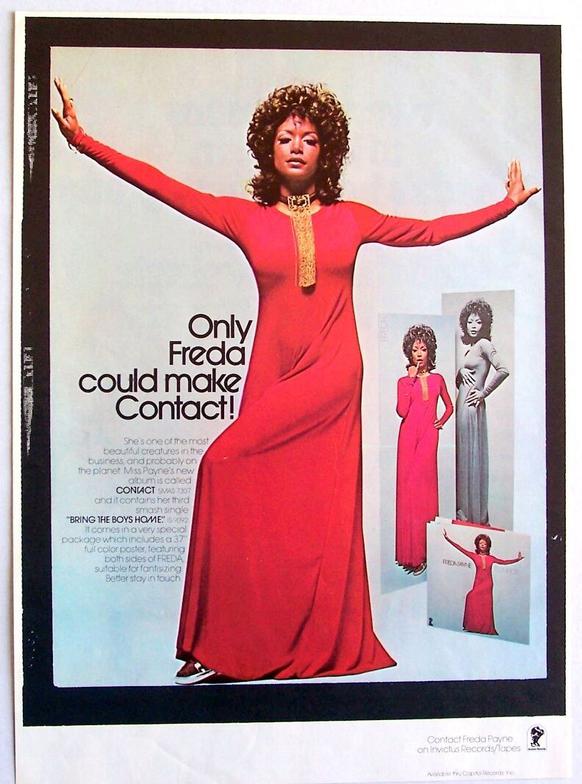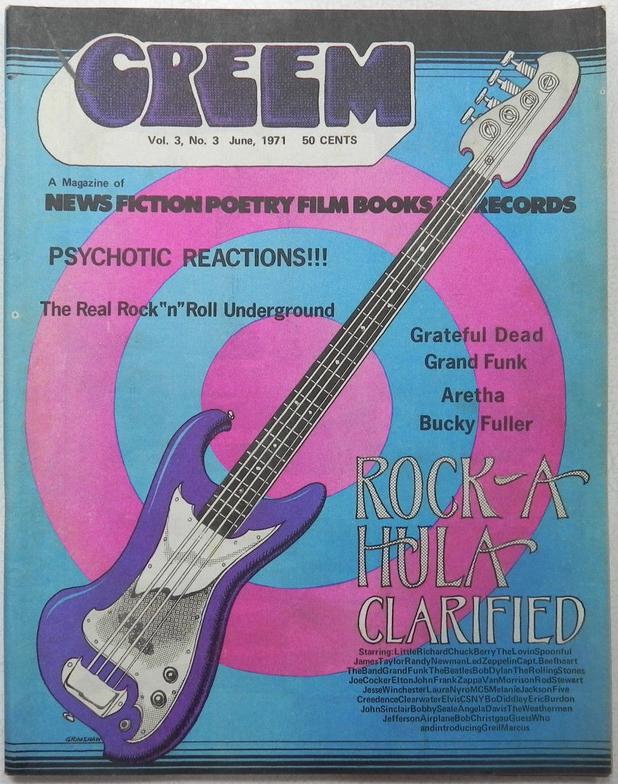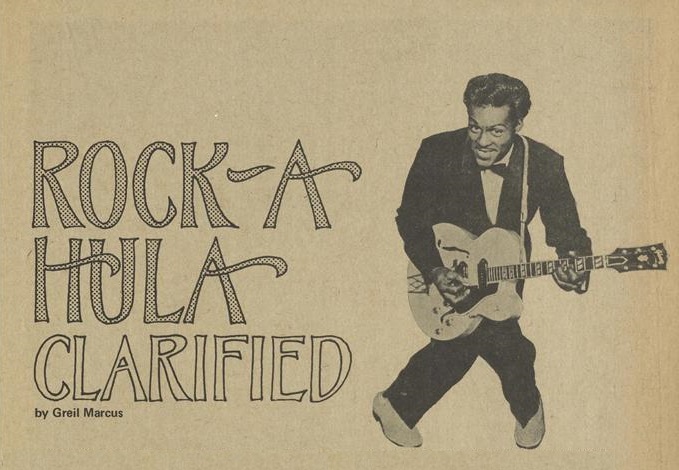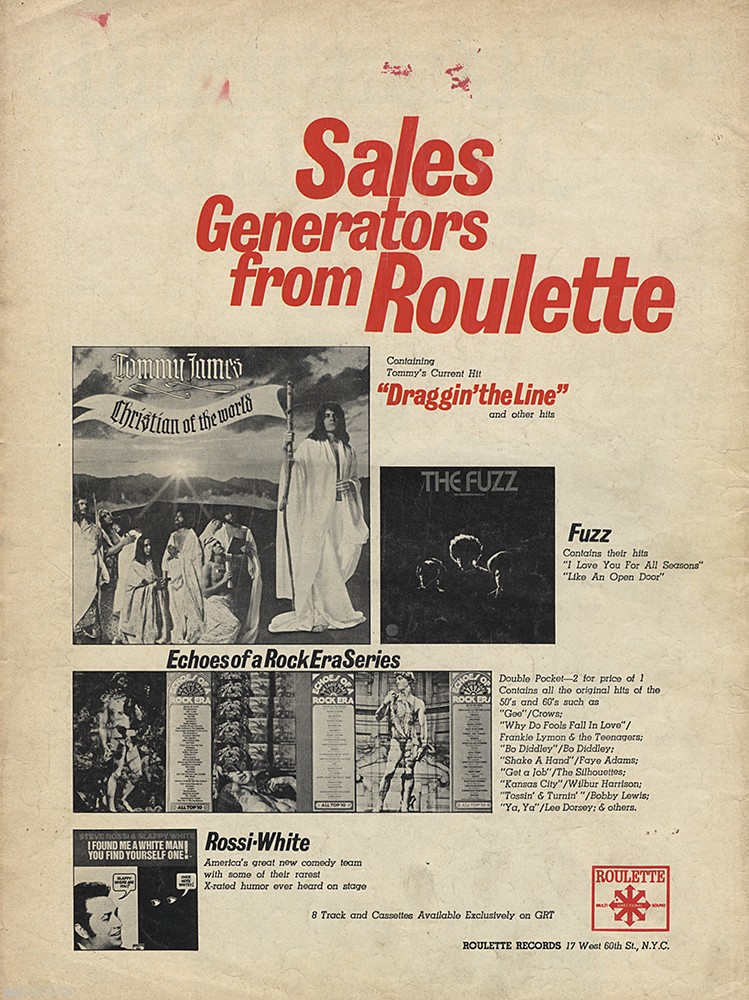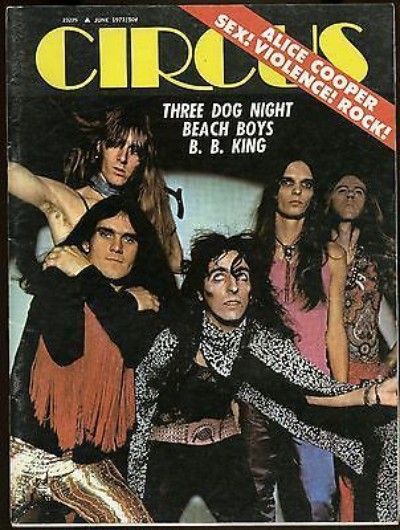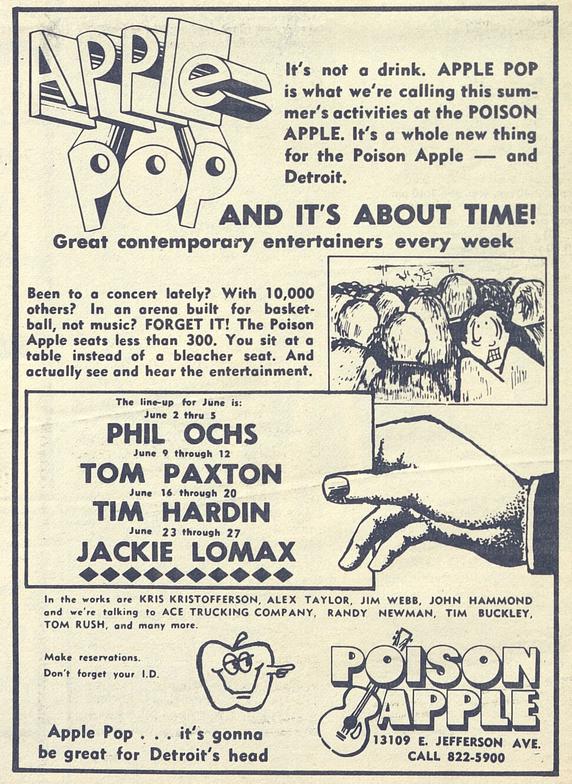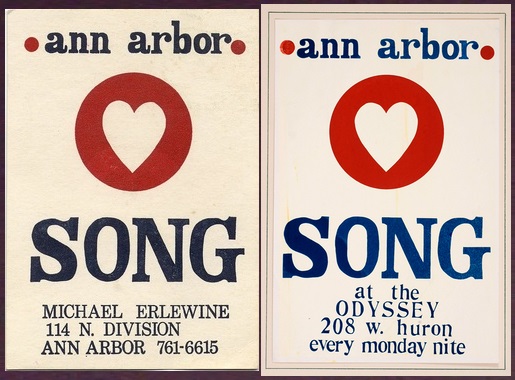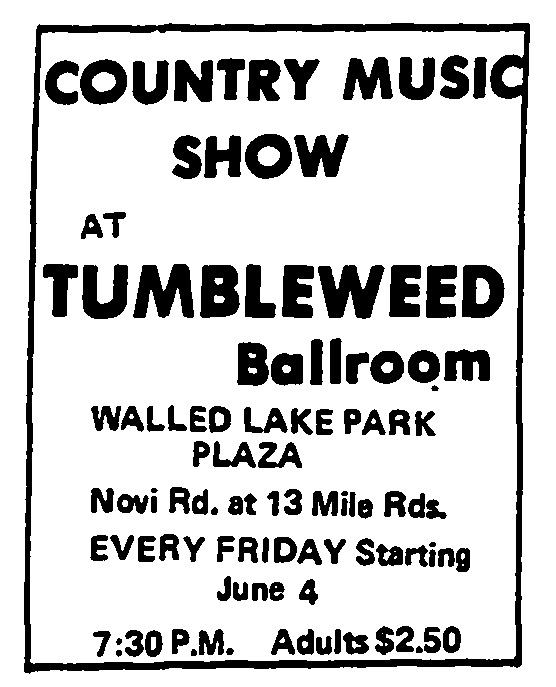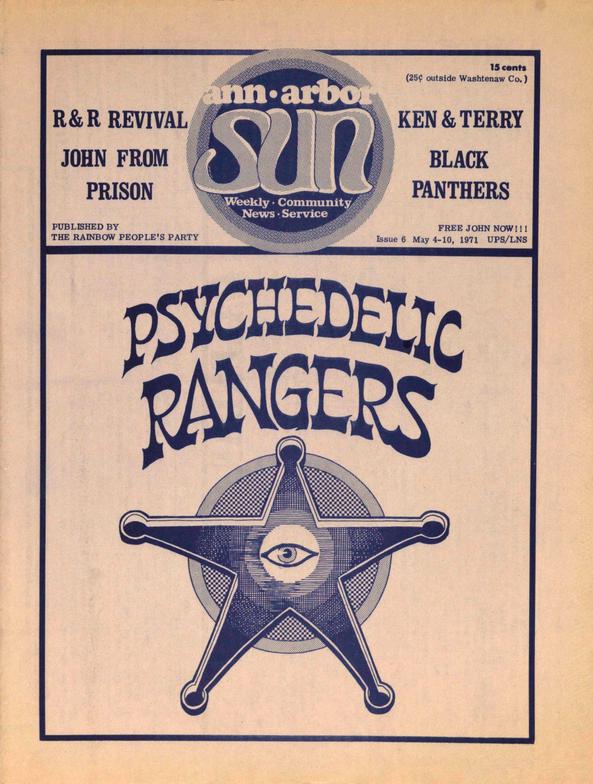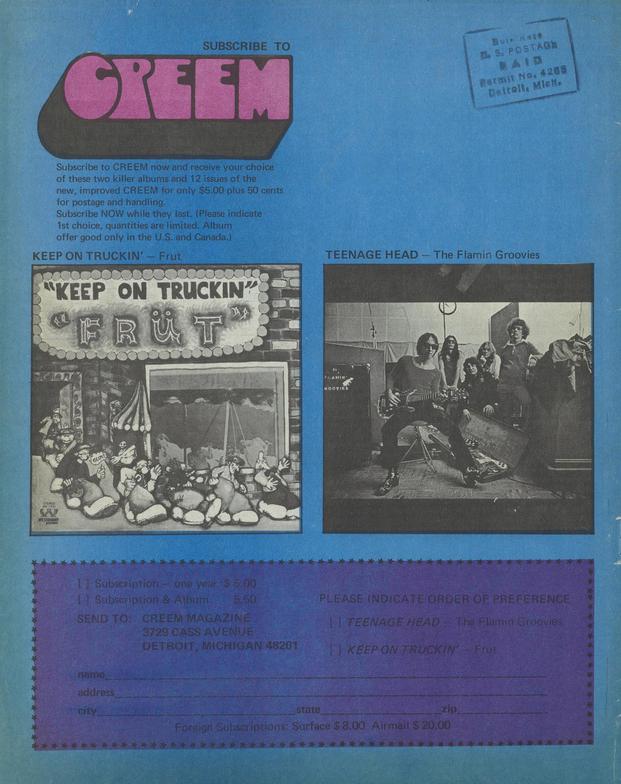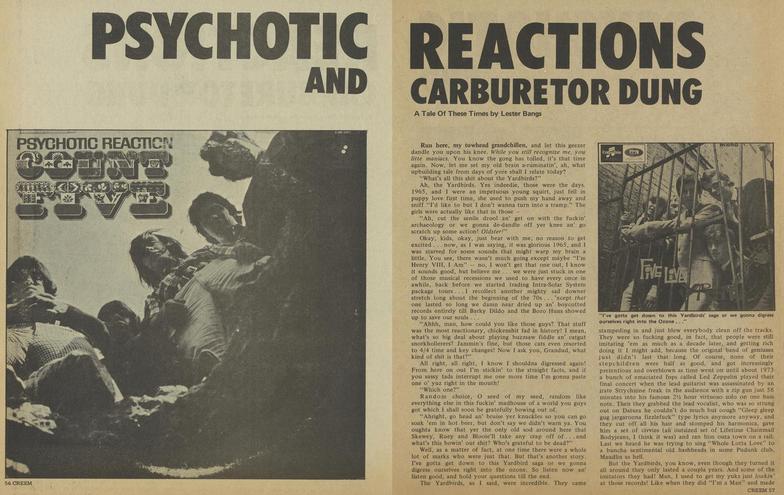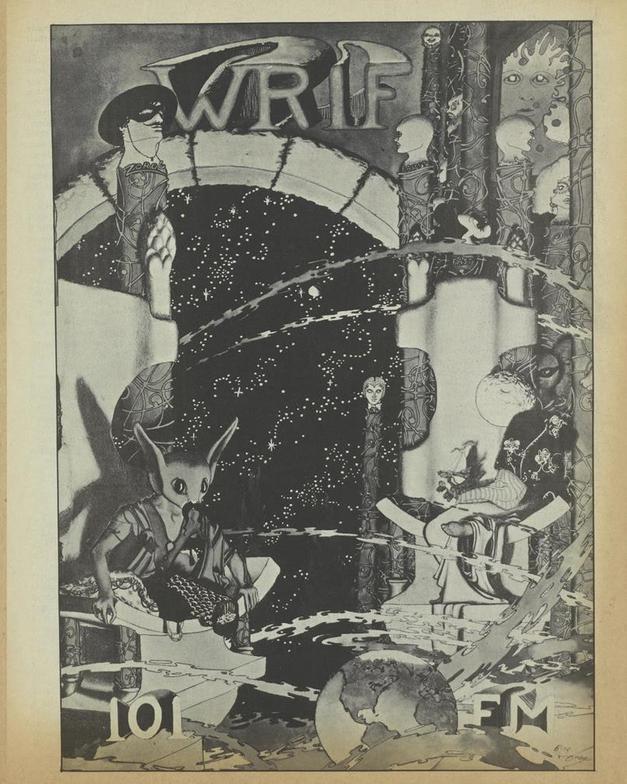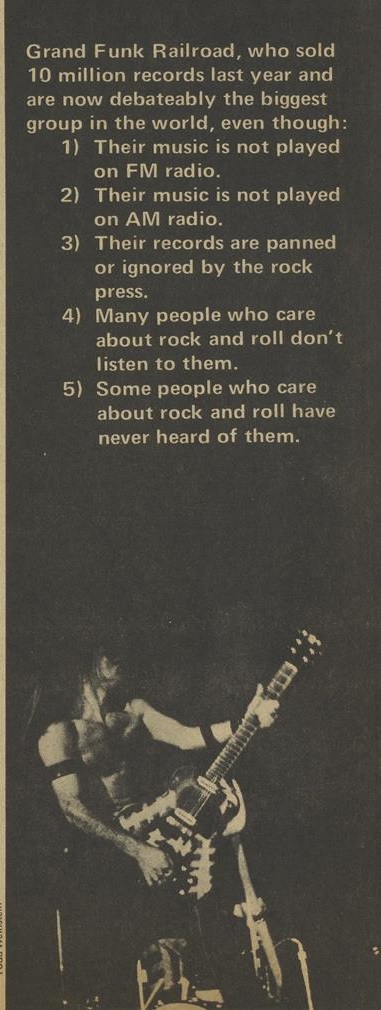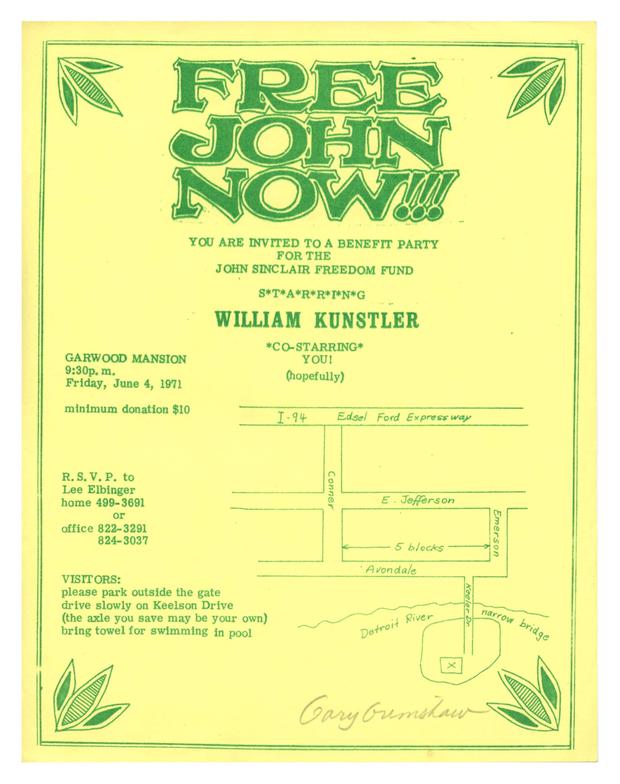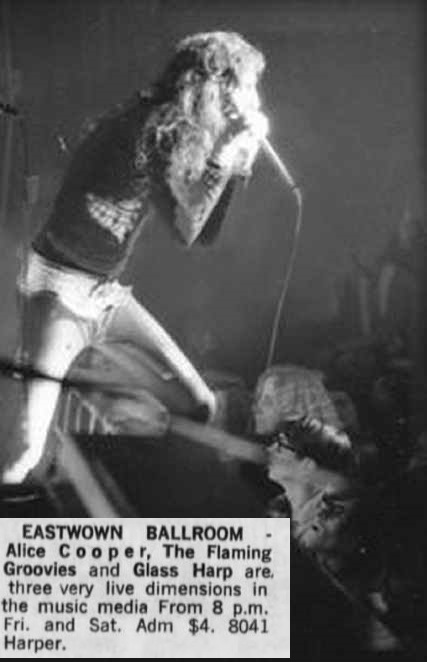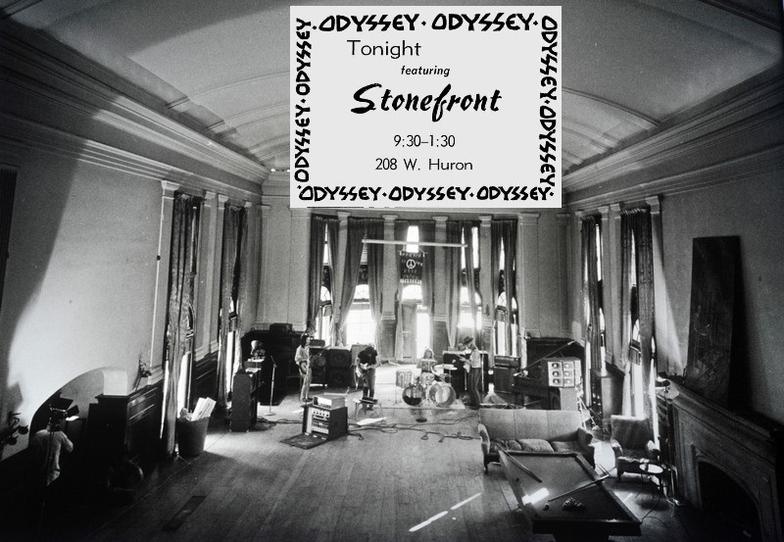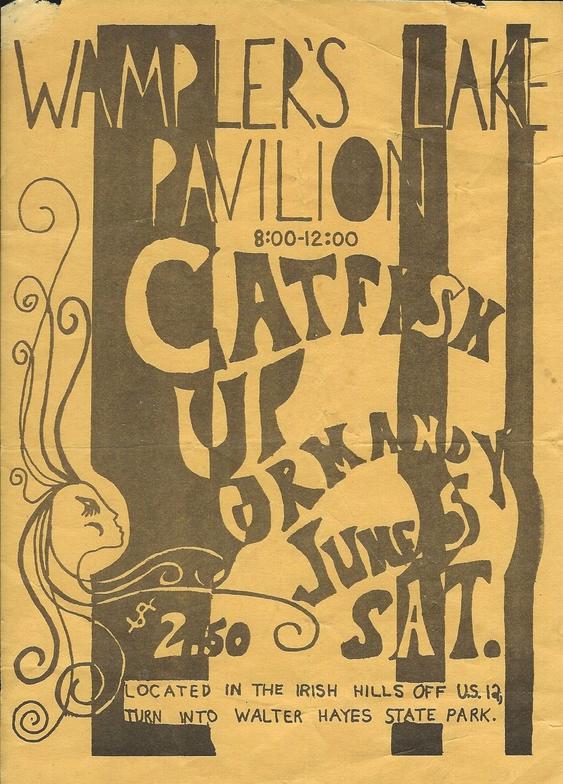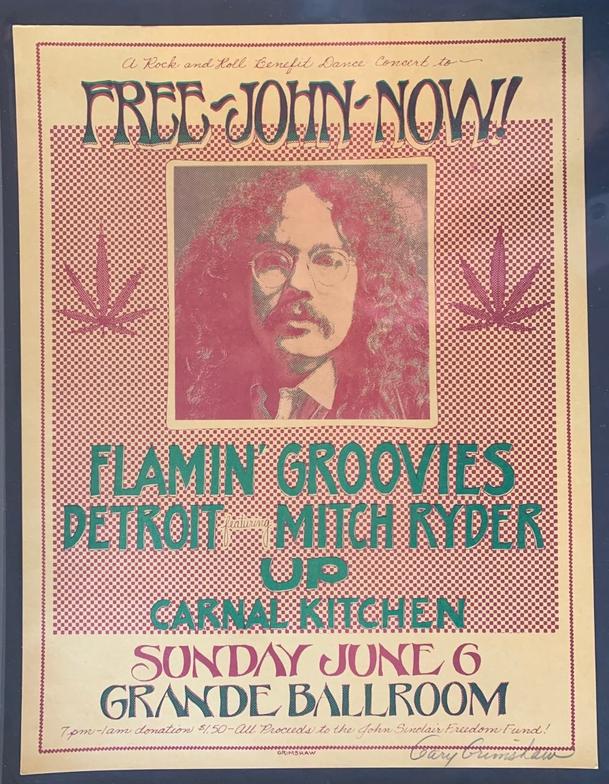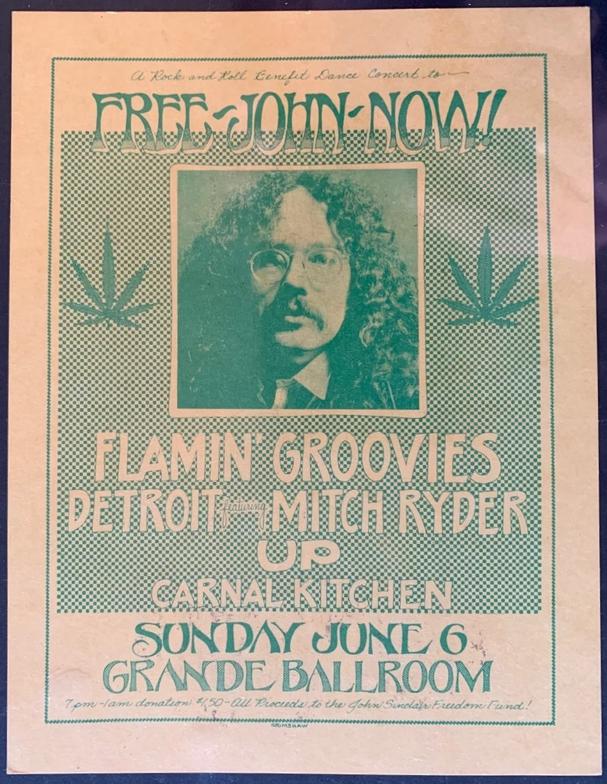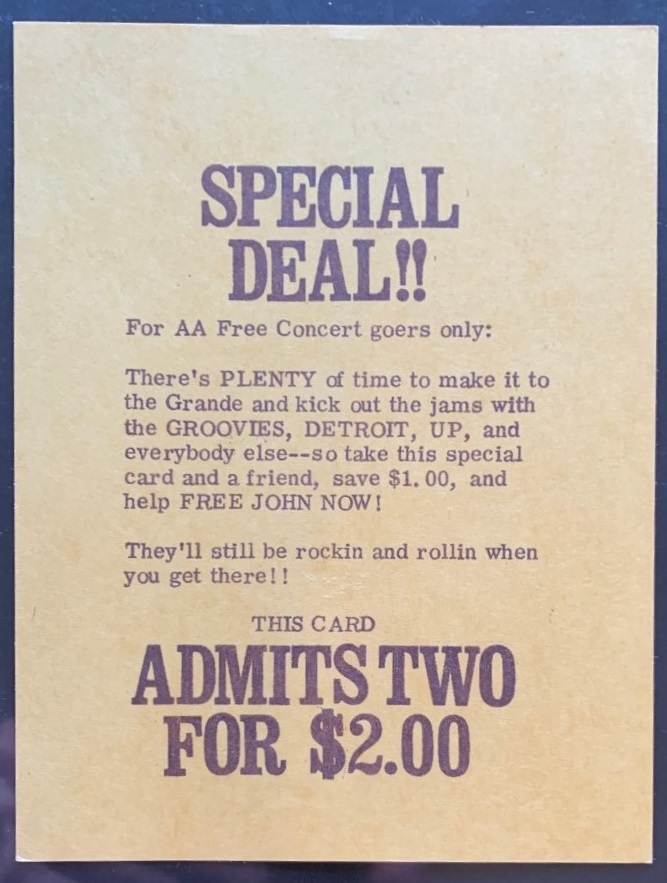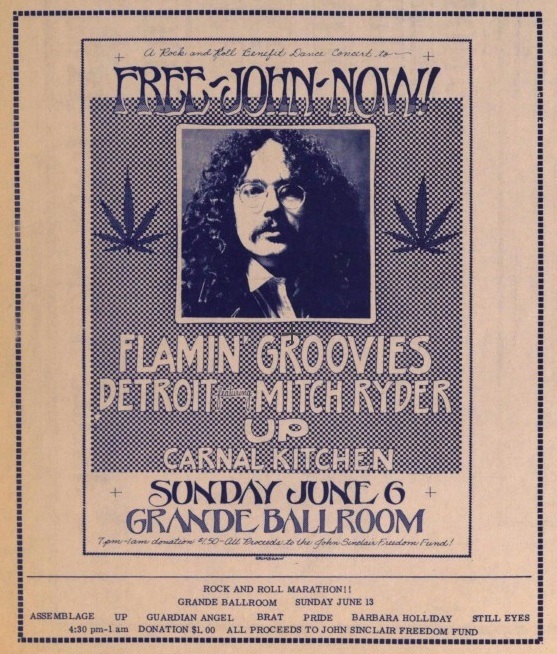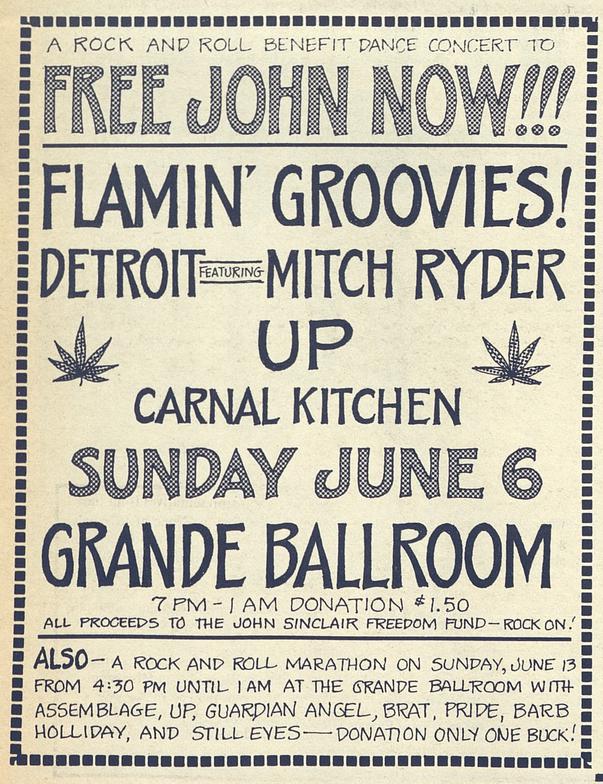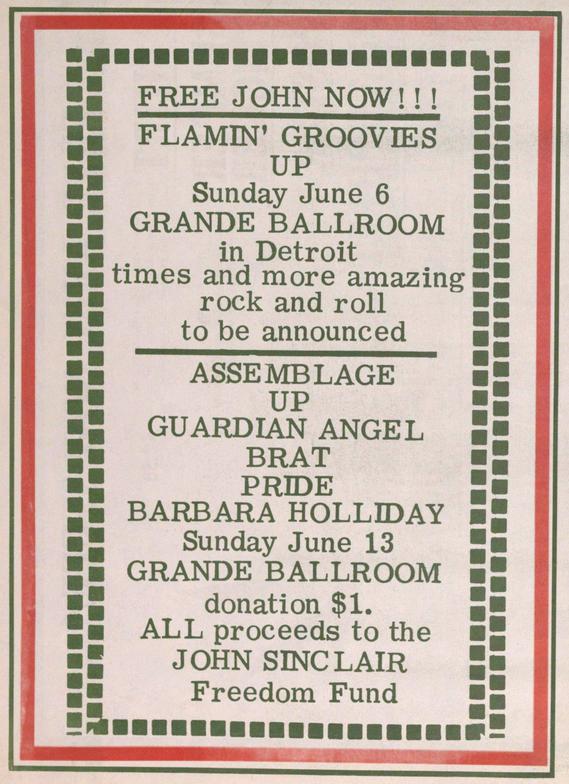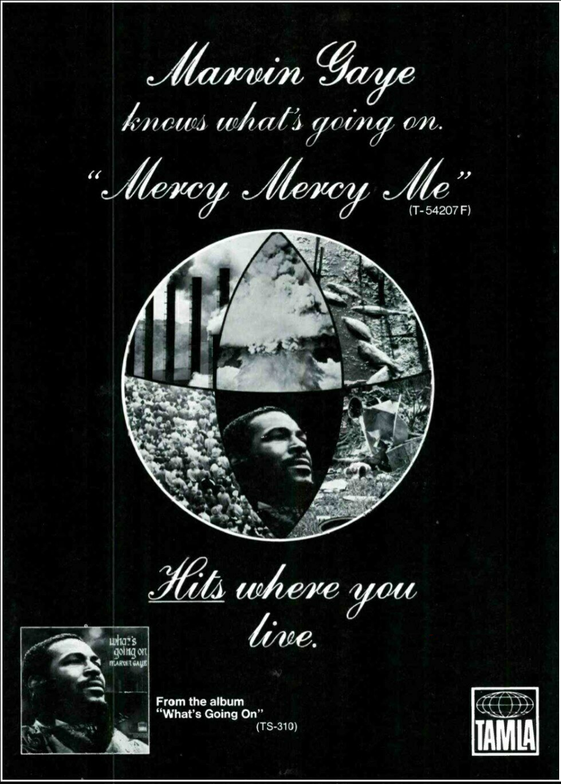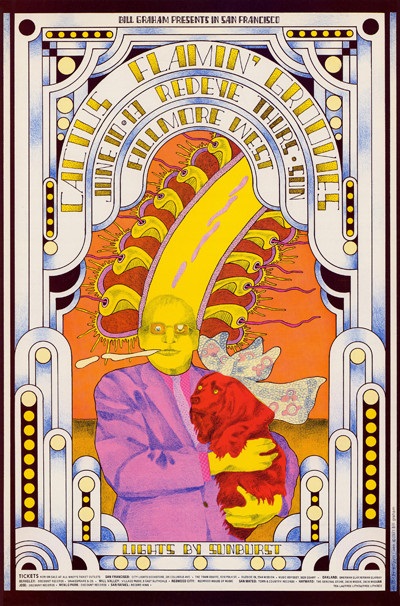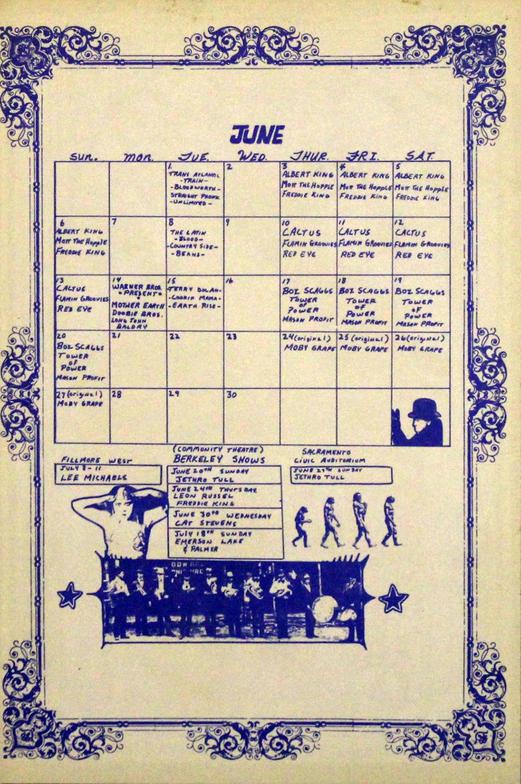Splatt Gallery
Double click here to add text.
Splatt Gallery's History of Michigan Concert Posters
Volume Seven - 1971 - Page Nine
***********************************************************
Frank Zappa & the Mothers of Invention made their ninth Michigan appearance, on May 25, 1971 at the Olympia Stadium in Detroit. They would return again four days later at Meadow Brook (Oakland University).
Full concert recordings of both shows are found here (select #1. For Oakland University, and select #2. For Detroit)
Mothers of Invention – Live Detroit (05/25/71) – and – Live Oakland University (05/29/71)
https://www.setlist.fm/setlist/frank-zappa/1971/olympia-stadium-detroit-mi-7bda42a0.html
Poster by unknown artist for Frank Zappa & the Mothers of Invention at Olympia Stadium in Detroit, Michigan, May 25, 1971. Not sure what is meant by “1st Michigan Appearance”, as mentioned above, this was their ninth Michigan show over four and a half years, maybe they meant the first one in 1971.
Full-page ad in The Fifth Estate newspaper for Frank Zappa at the Olympia Stadium in Detroit, Michigan, May 25, 1971.
A power trio from Detroit called Head Over Heels was the opening band for Frank Zappa & the Mothers of Invention at Olympia Stadium, May 25, 1971. The group had been playing together since taking over for the Pleasure Seekers as the house band at a club called Arthur in November 1968. Head Over Heels recorded one album, which included the song “Right Away”, written by guitarist Paul Frank, that the Chicago band Styx covered on their first album in 1972.
Head Over Heels opened for Frank Zappa & the Mothers for at least seven shows on the May/June 1971 tour, including Chicago, Detroit, Madison, Wisconsin, Cleveland, Harrisburg, Pennsylvania, and at the Fillmore East, New York during Bill Graham’s final shows before closing down. It was also at these Fillmore East shows that John Lennon and Yoko Ono joined the Mothers of Invention for a set that was included on the Mother’s Fillmore East album.
Apparently at the Madison show, the promoters wanted local favorites, the Tayles, to open the show, but Zappa insisted on having Head Over Heels instead.
Unfortunately, this heady run of shows were the last for Head Over Heels, the band broke up, guitarist Paul Frank would form the later bands Fresh Start and Bruzer.
Head Over Heels – Right Away (1971)
https://www.youtube.com/watch?v=tu37r-_Gt1Q
The concert calendar for KSHE radio in St. Louis, Missouri with the Stooges at the Music Palace on May 26, 1971. The show was cancelled due to the band's equipment truck arriving too late and was rescheduled for the next night at the Factory in nearby St. Charles. At that show, Iggy accidentally hit guitarist Ron Asheton in the head with his mic, prematurely ending the show.
KSHE radio, which continues to flourish to this day, was originally started in the home of engineer Ed Ceries who constructed the station in his basement.
Two days before opening for Frank Zappa & the Mothers of Invention at Meadow Brook, Livingston Taylor performed a headlining show at the Fountain Street Church in Grand Rapids, Michigan, May 27, 1971.
A second Detroit group had garnered the attention and assistance from a Rolling Stones producer. We recounted earlier how the band Sky came under the tutelage of Jimmy Miller, now the band Sunday Funnies found themselves working with the Stones’ original producer, Andrew Oldham, who was hired by Motown to help the band finish recording their first album.
Sunday Funnies – Crack in a Bell (1971)
https://www.youtube.com/watch?v=Jttsqlvlt2g
An ad for the first two Funkadelic albums in the May 28, 1971 issue of the British music magazine Blues & Soul.
Gary Grimshaw poster and flyer for the Union Ballroom in Ann Arbor, Michigan, May 28, 1971. The band Silver Hawk, which included Brian Dombrowsky, released one single on Westbound Records, a cover of George Harrison’s “Awaiting On You All”. Also on the bill were Sunday Funnies, UP, and Delta R.J. and the Bad Foot Blues Band.
Silver Hawk – Awaiting On You All (1971)
https://www.youtube.com/watch?v=KUCOnFdvWu8
A poster for a series of events in the final weekend of May 1971, in support of Free! John! Now!
The front cover of the May 28, 1971 issue of the Ann Arbor SUN newspaper, that re-uses the same photo by David Fenton that was on the cover of the April 30th issue.
The front cover of a special “Free John Now!” supplement to the Ann Arbor SUN newspaper, May 28, 1971.
Poster by an unknown artist from a special supplement issue of the Ann Arbor SUN, May 28, 1971.
Poster/flyer with Commander Cody opening for the Youngbloods at 660 Great Highway in San Francisco, California, May 28-29, 1971.
Flyer/ad by an unknown artist for Frank Zappa & the Mothers of Invention, at Baldwin Pavilion at Oakland University, better known as Meadow Brook, in Rochester Hills, Michigan on May 29, 1971.
Just four days after they performed at the Olympia Stadium in Detroit, Michigan, Frank Zappa & the Mothers of Invention returned to the area, at Meadow Brook in Rochester Hills, May 29, 1971. Poster and full-page newspaper ad by an unknown artist.
Newspaper ad for Frank Zappa & the Mothers of Invention, at Meadow Brook in Rochester Hills, May 29, 1971. Bambu was a local band from Oakland University that got a favorable review after the show, “far sight better than most groups who are just getting started”, but were never heard from again.
An earlier ad by an unknown artist for Frank Zappa & the Mothers of Invention at Baldwin Pavilion in Rochester Hills, Michigan on May 29, 1971, before the opening acts of Livingston Taylor and Bambu were announced. Photo taken from the cover of Zappa’s “Chunga’s Revenge” album.
The opening weekend of the third season of summer concerts at Wampler’s Lake Pavilion on Onsted, Michigan, May 29, 1971. Bands were Sunday Funnies, Third Power, Frut, Mike Quatro’s Jam Band, Silver Hawk, Cradle, Tea, and Jonathon Round. Poster by an unknown artist.
A series of mishaps and mayhem plagued the Stooges throughout May 1971. A concert scheduled for the 13th at Northport High School in Long Island, New York was cancelled when the school board determined that Iggy was “a crowd agitator. A show on the 16th at the University of Guelph in Canada was cut short because it interrupted the headmaster’s sleep.
Scheduled for two nights at the Eastown Theater in Detroit, May 21-22, the first night was cancelled because drummer Scott Asheton crashed the band’s van into a low bridge and was hospitalized. Steve Mckay filled in to play the drums for the second night. A show in St. Louis on the on the 26th was cancelled because the band’s equipment truck showed up late. The band arranged a make-up show the next day in nearby St, Charles, Missouri, during which Iggy accidentally whacked guitarist Ron Asheton in the head with a microphone, essentially ending the show. A show scheduled for the next day, the 28th, in Walled Lake, Michigan*, was cancelled because the band was still in Missouri because of the un-planned make-up show.
Finally, at the show in the above poster, at the Sports Arena in Toledo, Ohio, May 29, 1971, Iggy and guitarist James Williamson had had enough and both of them quit the band.
*The show in Walled Lake was to take place at the Tumbleweed Ballroom, which supposedly was a venue that Russ Gibb opened on the site of the old Walled Lake Casino. As we recounted earlier, the Walled Lake Casino burned down on Christmas night of 1965, we don’t know any structure that was built in its place, or what would have happened to it. We’ve come across other references to a Tumbleweed Ballroom in Walled Lake, but still can’t find anything definitive on it, so we’re asking our very knowledge readers if they can tell us anything about this. Thanks!
The database has four shows for the Tumbleweed Ballroom at 1903 Old Novi Road in Walled Lake, Michigan:
4/17/71 – Detroit with Frut, Glass Candle, and Track
6/5/71 – Detroit
6/12/71 – Still Eyes with Bornagain and Toby Redd
6/19/71 – Catfish
Nice poster by an unknown artist for the Stooges, Bob Seger (misspelled, as usual), Sunday Funnies, and Frut at the Toledo Sports Arena, May 29, 1971. As described in our previous post, this is the show when Iggy and James Williamson quit the Stooges.
Poster by an unknown artist for Alice Cooper and Brownsville Station opening for John Mayall at the Will Rogers Coliseum in Fort Worth, Texas on May 29, 1971. The same poster with the same line-up will also be used for the upcoming show in Houston Texas on May 31, but this one is in color.
Two years after the first Detroit Rock & Roll Revival in 1969, “The Return of the Detroit Rock & Roll Revival” returned to the Michigan State Fairgrounds, May 30, 1971, presented by the Eastown Theater. Poster by an unknown artist looks like someone took Gary Grimshaw’s lettering from the poster for the 1969 event.
The Ann Arbor Sun newspaper, who were no fans of either Bob Bagaris or Gabe Glantz ran a couple of stories about the 1971 version of the Rock & Roll Revival that focused on the poor facilities, the outrageous prices, the lack of Detroit bands, the bad vibes and the death drugs, and highlighted the differences between this one and the one in 1969 that had been organized by John Sinclair and Russ Gibb. But of the most interest to us, they mentioned, almost in passing, that the Rainbow People’s Party had designed and sold posters of the RRR. We’d love to see what it looked like, have never seen one.
Two posters for Alice Cooper and Brownsville Station, opening for John Mayall in Houston, Texas, May 31, 1971.
Released in May 1971, the single “Bring the Boys Home” by Freda Payne was added to the second pressing of her album “Contact”, a package from Invictus Records which included a 37” poster. In spite of the controversial political nature of the song, which caused it to be banned on the Armed Forces Network, the single became Payne’s second gold record.
Freda Payne – Bring the Boys Home (1971)
https://www.youtube.com/watch?v=08DGnRIIK7Y
The June 1971 issue of CREEM magazine featured cover art by Gary Grimshaw.
This was the first issue to feature writer Lester Bangs as a staff member, with a story called "Psychotic Reactions and Carburetor Dung", which is also the title of a 1987 compendium of Bangs’ work, edited by Greil Marcus, who incidentally also authored the cover story "Rock-A-Hula Clarified" in this issue.
Gary Grimshaw lettering for the cover story of the June 1971 issue of CREEM magazine.
A Roulette Records ad promoting the second solo album by Tommy James and the hit single “Draggin’ The Line” which was released in June 1971.
Tommy James & the Shondells had racked up staggering numbers since their debut #1 hit single “Hanky Panky” in 1966, with 23 gold singles, 9 gold and platinum albums and over 100 million records sold worldwide. During 1968 – 1969, the group allegedly sold more singles than any other group in the world, including The Beatles.
It all came to a crashing end when, at a concert in Birmingham, Alabama in March 1970, James collapsed after coming off stage and was actually pronounced dead. Cheating the Grim Reaper, he recovered, but he decided to leave the music business to recuperate. The rest of the band carried on as Hog Heaven, releasing two albums over the next three years before disbanding.
James returned as a solo artist and resumed a lengthy recording career, scoring another, although his last, Top Ten hit with the classic loopy bass riff of “Draggin’ The Line”.
Tommy James – Draggin’ The Line (1971)
https://www.youtube.com/watch?v=xLfO738Ok5Y
Alice Cooper became the third Michigan rock group to appear on the cover of Circus magazine with the June 1971 issue, five months since the Grand Funk cover and twenty months since the MC5’s September 1969 issue. As with many national, and international magazines, Alice was a favorite cover star, he would appear on the cover of Circus magazine at least six more times over the next few years.
According to the database, the last shows at the Poison Apple on Jefferson Avenue in Detroit Michigan before this, were when the Spike Drivers played a string of shows there in 1966. We don’t know if it was actually dormant since then (probably not), but they came back in June 1971 with what The Fifth Estate newspaper called “a new entertainment policy” called Apple Pop, trying to appeal to a new audience, with a poster/ad by an unknown artist.
The Prime Movers, Ann Arbor’s best, and longest-running, blues band since 1965, finally called it quits in June 1971 and disbanded. Band founder Michael Erlewine, the only remaining original member at this point, carried on as a solo act, billing himself (and making the posters) as Ann Arbor Heart Song, performing Monday nights at the Odyssey bar.
A rare ad for the Tumbleweed Ballroom in Walled Lake, Michigan, with a weekly Country Music Show beginning on June 4, 1971.
Despite having the wrong date, this is the front cover of the June 4, 1971 edition of the Ann Arbor SUN newspaper in Ann Arbor, Michigan, with Gary Grimshaw’s logos for the SUN and for the Psychedelic Rangers.
The first two pages of Lester Bangs’ story “Psychotic Reactions and Carburetor Dung” in the June 1971 issue of CREEM magazine.
A full-page black and white version of Brad Johannsen’s painting for WRIF-FM radio station in the June 1971 issue of CREEM magazine.
The enigma of Grand Funk Railroad was laid out in the June 1971 issue of CREEM magazine.
Invitation and map to the Garwood Mansion in Detroit, Michigan by Gary Grimshaw for a “Free John Now!!!” benefit party on June 4, 1971 with guest speaker, lawyer William Kunstler, who as we reported earlier, had joined the CIA Conspiracy Trial defense team.
Photo of Alice Cooper at the Eastown Ballroom(sic) from one of two shows, June 4-5, 1971.
The band Stonefront returned to the Odyssey bar in Ann Arbor, Michigan, June 5, 1971, they had earlier played there at least three times. The flyer is superimposed over a photograph of the band rehearsing at their headquarters in the infamous Garwood Mansion in Detroit.
Poster by an unknown artist for Catfish, UP, and Ormandy at Wampler’s Lake Pavilion in Onsted, Michigan on June 5, 1971.
Poster by Gary Grimshaw, for the Grande Ballroom in Detroit, Michigan, June 6, 1971.
This was at least the ninth show that San Francisco’s Flamin’ Groovies played in Detroit, they opened for Alice Cooper at the Eastown Theater four times, including the two nights before this show at the Grande. It was their third show at the Grande Ballroom, having opened for the MC5 twice in February 1970, an experience which changed the course of the band, according to band member Roy Loney:
“The first time we got into Detroit, it just clicked. Just did. We walked into the Grande and there was the MC5, and “What the FUCK is that? I wanna do THAT!” It really turned us around quite a bit. It radically changed our sound. We got HEAVIER after the Detroit experience. We saw the Stooges, the Frost, you know we just said “Wow, this is GREAT, this is SOMETHING ELSE AGAIN.” So it hardened up our sound quite a bit. I think “Flamingo” (the band’s second album) is pretty much an offshoot of the Detroit experience.”
This is their third album, which had just been released in March/April of 1971:
Flamin’ Groovies – Teenage Head (album) (1971)
https://www.youtube.com/playlist?list=PL8a8cutYP7fq0PHWgGXcuyK-SfrYdvVMi
A green print version of the poster by Gary Grimshaw, for the Grande Ballroom June 6, 1971 show.
The back side of the green print poster was a coupon for reduced admittance to the Grande Ballroom show on June 6, 1971 that was apparently handed out at the Ann Arbor Sunday Free Concert.
Newspaper version of the poster by Gary Grimshaw for the Grande Ballroom June 6, 1971 show.
Newspaper ad for the June 6, 1971 show at the Grande Ballroom, also announcing along the bottom, an upcoming follow-up show on June 13th.
Before we leave the Flamin' Groovies, here’s a clip of the Groovies from a 1972 TV program (German, we think), that shows just why they were the hardest rocking band out of San Francisco – and they’re still at it.
Flamin’ Groovies – Slow Death (live TV broadcast) (1972)
https://www.youtube.com/watch?v=EL3pP29N-Wc
One more poster from the Ann Arbor SUN newspaper for the Grande Ballroom show on June 6, 1971, also with the announcement for the following week.
A full-page Tamla Records ad for “Mercy Mercy Me”, released on June 10, 1971, the second single from Marvin Gaye's album, “What's Going On”. Like the title track, it also rose to #1 on the Billboard R&B Singles chart. It peaked at #4 on the Hot 100 chart, just two spots short of the #2 peak for the single “What’s Going On”.
Marvin Gaye – Mercy Mercy Me (The Ecology) (1971)
https://www.youtube.com/watch?v=NtlV0j0uGaA
Poster/handbill by Willyum Rowe for four shows by Cactus and Flamin’ Groovies at the Fillmore West in San Francisco, California, June 10-13, 1971.
Volume Seven - 1971 - continues - HERE


